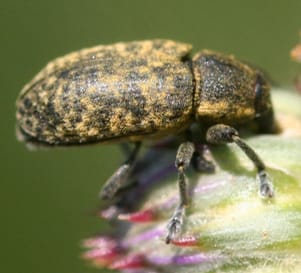Weevils as Biocontrol

The biological control project of placing the Rhinocyllus conicus weevil onto musk thistle flower heads in several contracted acres being undertaken on the Mescalero Apache Reservation by the Sovereign Nation Service Corps raises the question of whether such a method could be used here in Ruidoso.
The answer according to the Associate Dean and Director of NMSU’s Agricultural Experimental Station Dr. David Thompson is a qualified yes.
“The weevil is a very effective biocontrol agent,” Thompson said. “It is one such control that is good for getting rid of musk thistles.”
First introduced into the United States in 1969, the first success was documented six years later in Virginia. In areas where the weevil were introduced, there was an 80 to 95 percent stand reduction, according to Dr. Anthony Shelton on the Cornell University website on biological control.
Unfortunately, the weevil attacked all species of thistle, both native and invasive.
In 1969, thistles were not valued, so, according a Washington State University website on its Integrated Weed Control Project, the weevil was approved. Due to its uncontrollable destruction of the now revalued native species, the USDA revoked permits for interstate shipment of the insects in 2000; a rejection also taken by the college.
The Sacramento Mountains thistle is one such native species that was believed to be threatened by the introduction of the weevil. Also an endangered species, was the subject of a study in 2007 by Thompson who along with Kevin T. Gardner, Joyce E. Parker and Brian Zens found that the presence of musk thistle did not directly impact the survival of the smaller Sacramento Mountains thistle. Additionally, the presence of the weevil was negatively affected by less space and food afforded by the native thistle, making much of the concern moot.
“The two thistles don’t necessarily inhabit the same areas,” Thompson said. “That the musk thistle has become so prolific is more of a concern now and that the weevil has are well established and have been here for years means that if there is a thistle, there is probably a Rhinocyllus conicus.”
The adult weevil is black, has a snout and grows to be a little less than a quarter of an inch. The insect may appear to be yellowish due to its hair tufts that are shed with age and are typically found on the seed head in early summer. Eggs are laid on the brachs of the stem of the musk thistle and the larvae eat their way up into the buds. The pupae look like small, white worms and form in the thistle heads.
“The eggs and the pupae are real obvious,” Thompson said. “One way to transfer the insect is by clipping the entire head off of the musk thistle with the pupae and putting it onto another plant.”
The Sovereign Nation Service Corps members are picking individual weevils off plants, placing them into vials and then transporting and placing them on specific thistle blooms elsewhere, a painstaking process.
The reason Thompson’s answer is only a qualified yes is that while this is an effective method, it may be that, with the profusion of thistles, the weevil may find its way to its food source naturally.
“There is a cyclic pattern in play,” Thompson said. “The thistles appear, then come the insects. The weeds disappear and the insects move on. There is usually a delay, but as the population of thistles increases, so does the population of insects. If the thistle population declines, so will the weevils. They both fluctuate in relation to one another.”
This season’s rain has produced abundant thistles but even with aggressive treatments either with vinegar and liquid soap or weevils, there is no guarantee that thistles will not come back. Musk thistle reproduces only by seed, so long-term management centering on preventing seed production is the key to eradicating the invasive species.
According to Thompson, this presents a challenge.
“The seeds are numerous and long-lived,” Thompson said “Seeds can be in the ground for five or ten years and then suddenly germinate.”
Adding to the challenge is that seedlings may form both in early spring and fall, and one plant may produce over 20,000 seeds.
Weevils as a biocontrol agent remains a promising option according to Thompson even as state and federal policies remain in place to prevent the importation of the insect in the area.
“Then again, they are already here,” Thompson said.